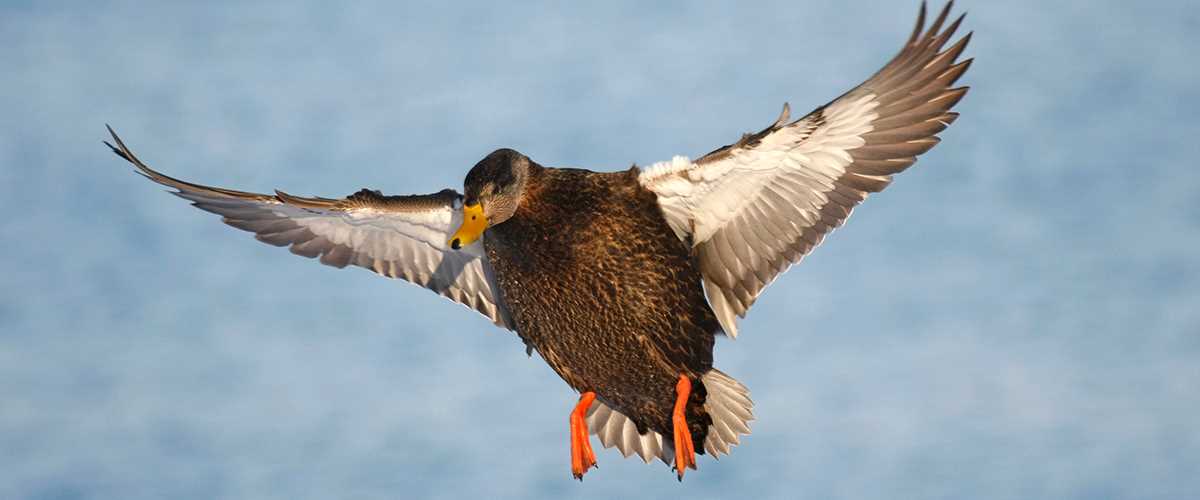The Salt Marsh Sovereign
Food and habitat resources needed for wintering black ducks
Food and habitat resources needed for wintering black ducks

By Tina Yerkes, Ph.D.
The American black duck, considered by many in the Atlantic Flyway to be the king of all ducks, is prized by coastal hunters. Black ducks were once the predominant species harvested by Atlantic Flyway waterfowlers. Unfortunately, wintering black duck numbers have declined by as much as 60 percent. One of several possible explanations for this decline is the loss and degradation of coastal habitat where the birds winter. Coastal salt marshes are the most threatened wetland systems in North America.
Oddly enough, despite higher historic wetland losses and extensive development, wintering numbers of black ducks have stabilized in the northern part of the Atlantic Flyway. But south of New Jersey, where wetland losses have been less severe, wintering numbers continue to decline.
Can remaining habitat support the current wintering population of black ducks? And how much more coastal wetland habitat needs to be restored and protected to support the North American Waterfowl Management Plan's (NAWMP) population goal for black ducks? These are the primary questions DU and its partners have set out to address through recent research projects.
Wintering habitat limitation on duck populations is rare. Most ducks survive the winter relatively well. But if this limitation is going to occur, it will likely be found in the Atlantic Flyway, where extensive wetland losses and intense development have degraded salt marsh habitats and introduced human disturbance.
During the winter and spring, food is very important to ducks for survival and preparation for the upcoming breeding season. To understand the food resources currently available to wintering black ducks and to adapt habitat programs to "fill in the gaps" along the Atlantic Flyway, Ducks Unlimited and multiple partners recently completed a study on Long Island, New York. This study has been extended to additional sites in Virginia and New Jersey.
To learn more about black duck habitat use and food resources, researchers trapped 30 hens and fitted them with radio transmitters during the winters of 2004-2005 and 2005-2006. The transmitters allowed researchers to determine overall movements as well as habitat use and behavioral activity while the birds were in different habitat types. Researchers also conducted extensive sampling of invertebrates and seeds in wetland habitats used by black ducks to determine the type and amount of food available for the birds. The same type of study will be done in Virginia and New Jersey so that biologists can compare "apples to apples" on a flyway-wide scale and determine habitat restoration or protection needs throughout the flyway.
Based on results from Long Island, black ducks eat and sleep the winter away and spend little time doing much else. During the Long Island study, hens fed mostly on mudflats and in salt marshes, but they slept and loafed in freshwater and brackish habitat. Not surprisingly, the highest numbers of invertebrates were found in mudflats and salt marshes. In a similar study at the Meadowlands in New Jersey, salt marshes that were tidally influenced and had native vegetation (spartina) produced more invertebrates than tidally-restricted salt marshes or wetland habitat that was dominated by invasive phragmites. In both cases, feeding habits were timed with the tides except during hunting season, when the birds spent most of the day hiding in protected areas and not feeding until after dark.
When favored feeding habitats freeze during the winter, black ducks and other species of migratory birds face an interesting dilemma: Should they stay or should they go? Some hens do not make very good decisions, as they remain in frozen areas and starve to death during severe weather events. During the first year of the study, a hard freeze hit Long Island. Some hens flew farther south to the Chesapeake Bay area, but some remained and moved into freshwater habitats in an attempt to weather the storm. Unfortunately, several hens did not survive. Poor body condition caused by insufficient winter food resources may account for why hens remain and are unable to survive freeze events.
During severe winters, managed impoundments and grid-ditched marsh systems freeze quickly, leaving few areas where black ducks can feed. The last study sites to freeze were restored salt marshes with adequate tidal flow. These habitats were restored by plugging old drainage ditches and through integrated marsh management or open-water marsh management. Black ducks are notoriously shy and tend to stay away from overly developed or disturbed areas. Many areas preferred by black ducks tracked during the study were relatively undeveloped watersheds with parks, state conservation lands, or refuges. Because of the birds' behavior and feeding habits, and their need to maintain fat reserves, an ideal management approach would be to provide freshwater resting sites near restored salt marshes with tidal influence and mud flats that experience little disturbance.
Additional study sites in Virginia and New Jersey offer the opportunity to examine how food resources, habitat use, and behavior change throughout the flyway. To meet the needs of wintering black ducks, it will likely be critical to provide undisturbed, food-rich habitat at a flyway-wide scale. This would allow black ducks to move out of one area and into another when severe weather hits or disturbance is too great, while still supplying the food resources the birds need to survive and prepare for spring migration and egg laying.
Dr. Tina Yerkes is director of conservation planning at DU's Great Lakes/Atlantic Office in Ann Arbor, Michigan.